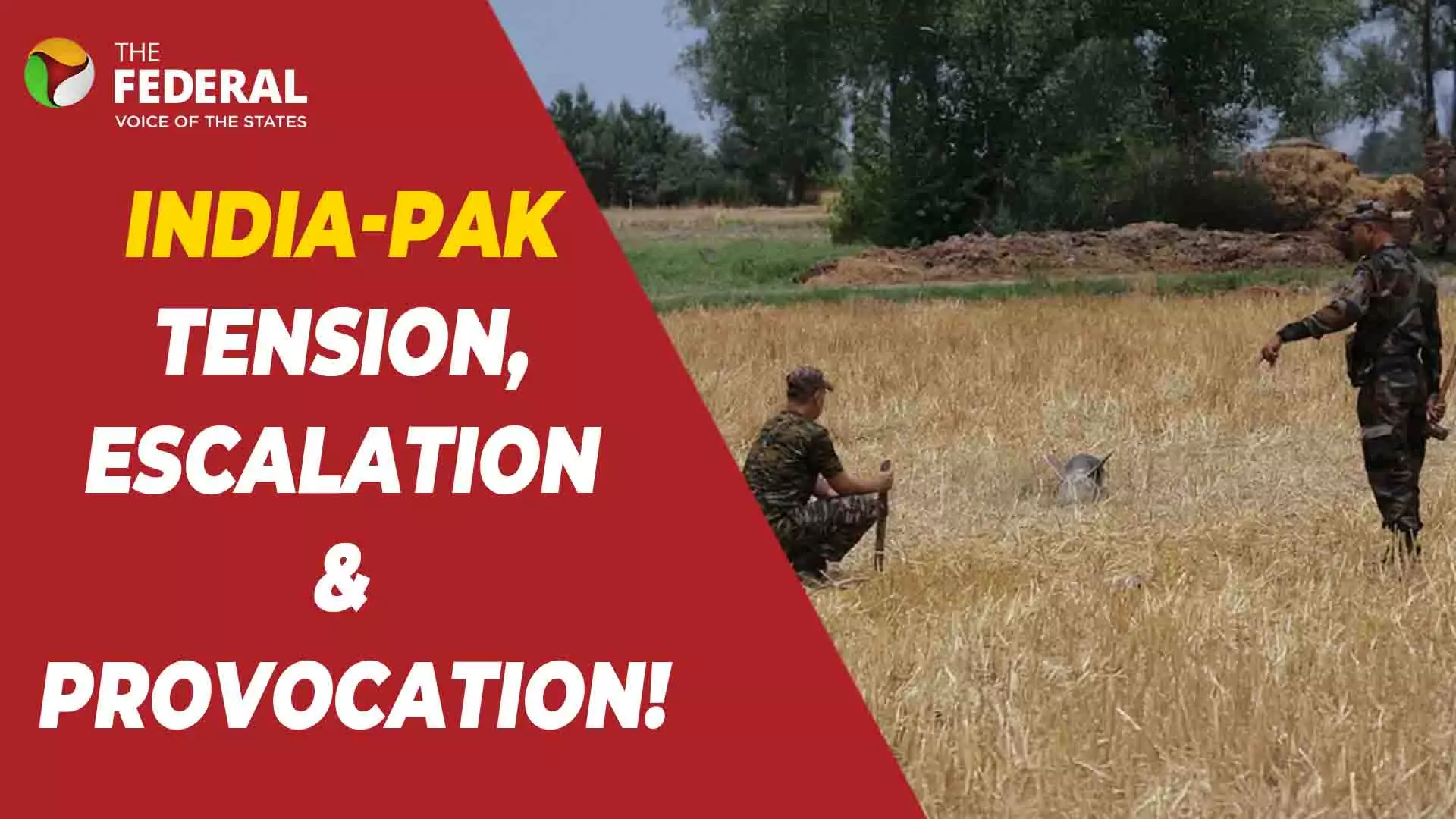
India-Pakistan conflict: Missiles, airbase strikes and diplomatic moves
The Federal’s Editor-in-Chief S Srinivasan breaks down the four-day military escalation, civilian impact, and India’s sharp diplomatic message to the world

As tensions between India and Pakistan reach a boiling point, with cross-border attacks and missile strikes dominating headlines, concerns rise over the potential for full-scale war. The Federal’s Editor-in-Chief, S Srinivasan, unpacks the latest developments, the nature of the escalation, misinformation in play, and India’s measured response.
Shweta Tripathi: We are now on day four of the ongoing operations between India and Pakistan. The Ministry of External Affairs (MEA) just briefed that there is increased troop movement along the borders. How do you assess the current situation?
S Srinivasan: Today’s briefing was quite significant. The two words used by the External Affairs Secretary were “escalatory” and “provocative.” He squarely held Pakistan responsible for this escalation.
Specifically, last night, after around 1:40 am, they launched high-speed missiles at India. According to reports, one such missile, believed to have been launched at Sirsa in Haryana (close to Delhi), was intercepted and its debris collected. Reports suggest it was a FATATO missile, which has a range of 250–400 km and is a surface-to-surface ballistic missile.
When we talk about “high speed,” we mean missiles traveling at Mach 3 to Mach 5—three to five times the speed of sound, which is about 1,235 km/h. The FATATO missile, an improved version of the FATA, can achieve Mach 3 speeds with a low circular error probability, meaning it can hit targets within a 20–33 feet radius.
This marks a serious escalation. Another escalation is the use of high-caliber equipment along the border. For context, a handheld rifle might be 0.22 caliber, but something like the Bofors gun, with a barrel length of about 20 feet, fires heavy artillery that causes far more damage. Reports suggest such artillery has been stepped up along the border.
The third escalation is the targeting of Indian airbases. Finally, Pakistan is massing troops along the border, signalling preparation for a longer battle. Together, these factors show the conflict’s escalation ladder rising sharply.
Shweta Tripathi: There has also been a lot of misinformation, like reports of Indian military infrastructure being destroyed. What’s happening there?
S Srinivasan: Yes, misinformation has been rampant. Reports claimed that BrahMos missile storage depots, power stations, and hydro sites had been destroyed or made dysfunctional. But the MEA dismissed this as propaganda. They even showed images of Indian airbases to prove they remain intact.
Shweta Tripathi: How has India’s response evolved over these four days?
S Srinivasan: India’s response has escalated strategically.
Day One: India targeted terror camps after Pakistan shelled border areas and sent drones.
Day Two: India launched retaliatory border strikes in response to Pakistani shelling along the Line of Control (LoC).
Day Three: India disabled air defences in Lahore to stop incoming fire.
Day Four (starting early today): India struck Pakistani airbases, including Noor Khan Air Base, Rahwali, Murid in Chakwal, and Rafiqui.
Importantly, Indian officials emphasised they are avoiding collateral damage, focusing only on precision strikes against military command and control systems. In contrast, Pakistan is targeting civilian infrastructure.
Shweta Tripathi: Speaking of civilians, there have been attacks in Srinagar, Udhampur, and Avantipura. Is Pakistan trying to disrupt India’s communal harmony? How is India handling this?
S Srinivasan: Unfortunately, Pakistan has attacked civilian sites, including a hospital in Jammu and Kashmir where a senior officer was killed. They’ve also made bizarre claims, like firing missiles targeting Punjab’s population or hitting gurdwaras and Christian missionary locations.
Meanwhile, India has exercised restraint, ensuring that civilian flights continue even as drones are intercepted. The Indian military’s focus remains on disabling infrastructure—like radar and airstrips—not targeting civilian or parked aircraft.
Shweta Tripathi: Is the public starting to feel fear or panic over the possibility of war?
S Srinivasan: Interestingly, people in the border areas—Jammu, Kashmir, Punjab, Haryana, and Rajasthan—are quite battle-hardened. News reports show they are mentally prepared, frustrated, but resilient.
While no one wants war, if it becomes inevitable, these communities tend to rally around their government and armed forces. Fear often transforms into determination and support, rooted in the psychological backdrop of decades-long tension.
Shweta Tripathi: Reports mention a Pakistani operation called “Operation Bunyan Marsus.” The MEA hasn’t confirmed anything. Is there any clarity on this?
S Srinivasan: India has named its operations—for example, “Operation Sindoor”—which has cultural significance. Pakistan, using its own cultural and religious framework, has named its counter-operations.
India’s defence establishment hasn’t officially responded to these names because the focus remains on tactical and military developments, not symbolic nomenclature.
Shweta Tripathi: Finally, on the IMF loan to Pakistan: India has raised concerns about its use. How does this play out internationally?
S Srinivasan: We’ll have a detailed story soon on how IMF funding works. But, in brief, IMF funds are not like regular bank loans. Countries contribute to the IMF based on their economic strength, and these pooled resources assist nations in crisis—usually to address foreign exchange shortfalls.
Pakistan is currently seeking $1.3 billion under the Extended Fund Facility, of which $1 billion has been approved. There’s no UN Security Council-style voting; about 25 members on the IMF board decide these matters.
India has used this moment to send a message: you are bailing out a country facing a forex crisis while it sponsors state terrorism that harms a democracy like India. New Delhi’s contention is that these funds could be misused, and it has urged contributing nations to reflect on where their money ultimately goes.
The content above has been generated using a fine-tuned AI model. To ensure accuracy, quality, and editorial integrity, we employ a Human-In-The-Loop (HITL) process. While AI assists in creating the initial draft, our experienced editorial team carefully reviews, edits, and refines the content before publication. At The Federal, we combine the efficiency of AI with the expertise of human editors to deliver reliable and insightful journalism.

